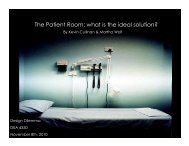The role of physical design and informal communication
The role of physical design and informal communication
The role of physical design and informal communication
You also want an ePaper? Increase the reach of your titles
YUMPU automatically turns print PDFs into web optimized ePapers that Google loves.
Stolte, K., & Myers, S. t. (1995). Reflections on recruitment <strong>and</strong> retention at the unit<br />
level. <strong>The</strong> Health Care Supervisor, 13, 36.<br />
Stryker, J. B. (2004). Designing the workplace to promote <strong>communication</strong>: <strong>The</strong> effect<br />
<strong>of</strong> collaboration opportunity on face-to-face <strong>communication</strong> in R&D project<br />
teams. Unpublished Doctor <strong>of</strong> Philosophy, Rutgers, <strong>The</strong> State University <strong>of</strong> New<br />
Jersey, Newark, New Jersey.<br />
Study devises ways to shorten steps <strong>and</strong> give nurses more time.(2008). Health<br />
Facilities Management, 21(3), 6.<br />
Sturdavant, M. (1960). Intensive nursing service in circular <strong>and</strong> rectangular units.<br />
Hospitals, JAHA, 34, 46-48, 71-78.<br />
Sweeney, B. A. (2008). <strong>The</strong> ecology <strong>of</strong> the patient experience: Physical environments,<br />
patient-staff interactions, staff behaviors, <strong>and</strong> quality <strong>of</strong> care. Unpublished<br />
Unpublished Master <strong>of</strong> Science, Cornell University,<br />
<strong>The</strong> Center for Health Design. (2006). <strong>The</strong> pebble project. Retrieved 6/30, 2008, from<br />
http://www.health<strong>design</strong>.org/research/pebble/<br />
Topf, M., & Dillon, E. (1988). Noise-induced stress as a predictor or burnout in<br />
critical care nurses. Heart Lung, 17(5), 567-574.<br />
Trites, D. K., Galbraith, F. D., Sturdavant, M., & Leckwart, J. F. (1970).<br />
Influence <strong>of</strong> nursing-unit <strong>design</strong> on the activities <strong>and</strong> subjective feelings <strong>of</strong><br />
nursing personnel. Environment <strong>and</strong> Behavior, 2(3), 303-334.<br />
Ulrich, R. S. (1984). View through a window may influence recovery from surgery.<br />
Science, 224(4647), 420.<br />
Ulrich, R. S., Zimring, C., Quan, X., & Joseph, A. (2006). <strong>The</strong> environment's impact<br />
on stress. In S. O. Marberry (Ed.), Improving healthcare with better building<br />
<strong>design</strong> (pp. 37-61). Concord, CA: <strong>The</strong> Center for Health Design.<br />
Ulrich, R. S., Zimring, C., Quan, X., Joseph, A., & Choudhary, R. (2004). <strong>The</strong> <strong>role</strong> <strong>of</strong><br />
the <strong>physical</strong> environment in the hospital <strong>of</strong> the 21st century: A once-in-a-lifetime<br />
opportunity. Concord, CA: <strong>The</strong> Center for Health Design.<br />
Ulrich, R. S., Zimring, C., Zhu, X., DuBose, J., Seo, H., Choi, Y., et al. (2008). A<br />
review <strong>of</strong> the research literature on evidence based-healthcare <strong>design</strong>. Health<br />
Environments Research <strong>and</strong> Design Journal, 1(3)<br />
Verderber, S., & Fine, D. J. (2000). Healthcare architecture in an era <strong>of</strong> radical<br />
transformation. New Haven, CT: Yale University Press.<br />
174







